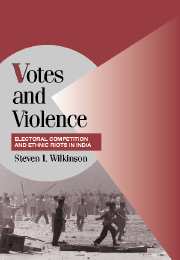Book contents
- Frontmatter
- Contents
- List of Figures
- List of Tables
- Acknowledgments
- 1 THE ELECTORAL INCENTIVES FOR ETHNIC VIOLENCE
- 2 EXPLAINING TOWN-LEVEL VARIATION IN HINDU-MUSLIM VIOLENCE
- 3 STATE CAPACITY EXPLANATIONS FOR HINDU-MUSLIM VIOLENCE
- 4 THE CONSOCIATIONAL EXPLANATION FOR HINDU-MUSLIM VIOLENCE
- 5 THE ELECTORAL INCENTIVES FOR HINDU-MUSLIM VIOLENCE
- 6 PARTY COMPETITION AND HINDU-MUSLIM VIOLENCE
- 7 THE ELECTORAL INCENTIVES FOR ETHNIC VIOLENCE IN COMPARATIVE PERSPECTIVE
- 8 DEMOCRACY AND ETHNIC VIOLENCE
- Appendix A Data Sources for Hindu-Muslim Riots
- Appendix B Data-Entering Protocol for Riot Database
- Appendix C Additional Results from Statistical Tables
- References
- Index
- Cambridge Studies in Comparative Politics
- References
Appendix A - Data Sources for Hindu-Muslim Riots
Published online by Cambridge University Press: 28 July 2009
- Frontmatter
- Contents
- List of Figures
- List of Tables
- Acknowledgments
- 1 THE ELECTORAL INCENTIVES FOR ETHNIC VIOLENCE
- 2 EXPLAINING TOWN-LEVEL VARIATION IN HINDU-MUSLIM VIOLENCE
- 3 STATE CAPACITY EXPLANATIONS FOR HINDU-MUSLIM VIOLENCE
- 4 THE CONSOCIATIONAL EXPLANATION FOR HINDU-MUSLIM VIOLENCE
- 5 THE ELECTORAL INCENTIVES FOR HINDU-MUSLIM VIOLENCE
- 6 PARTY COMPETITION AND HINDU-MUSLIM VIOLENCE
- 7 THE ELECTORAL INCENTIVES FOR ETHNIC VIOLENCE IN COMPARATIVE PERSPECTIVE
- 8 DEMOCRACY AND ETHNIC VIOLENCE
- Appendix A Data Sources for Hindu-Muslim Riots
- Appendix B Data-Entering Protocol for Riot Database
- Appendix C Additional Results from Statistical Tables
- References
- Index
- Cambridge Studies in Comparative Politics
- References
Summary
Problems with the Existing Data
As with most ethnic conflicts, systematic information on where and when Hindu-Muslim riots have taken place is hard to find. For the preindependence period, the only widely available source is a British report that gives detailed information on Hindu-Muslim riots from 1923 to 1927. And in the postindependence period, partly as a reaction to the colonial government's overemphasis on the Hindu-Muslim divide, Indian governments have not made information widely available. State governments keep riot commission reports secret or delay their publication for years. The central government instructs the state news media to provide no “inflammatory” information on riots, which in practice has sometimes meant no information at all. The government typically answers parliamentary questions about riots by placing the answers “on the table” of the house rather than publishing them in the parliamentary proceedings. And in India's annual crime reports communal riots are not listed separately but included in the general category of “riot,” together with union- and student-related violence.
Recognizing that these general “riot” data cannot be used to make inferences about the number of Hindu-Muslim riots, most scholars have turned instead to the Home Ministry figures on “communal incidents.” However, even though Home Ministry statistics provide an accurate picture of overall trends in Hindu-Muslim violence, they have three important limitations. First, they have only been published since 1954, making it impossible to test the claim that postindependence political and economic developments have led to an increase in communal violence.
- Type
- Chapter
- Information
- Votes and ViolenceElectoral Competition and Ethnic Riots in India, pp. 243 - 254Publisher: Cambridge University PressPrint publication year: 2004
References
- 1
- Cited by

